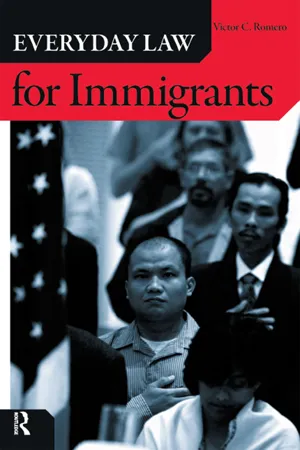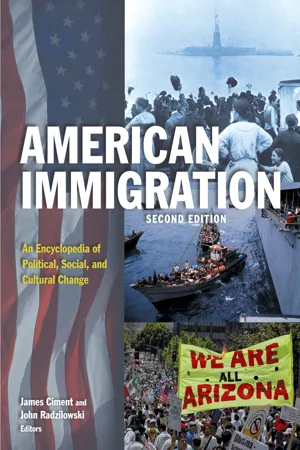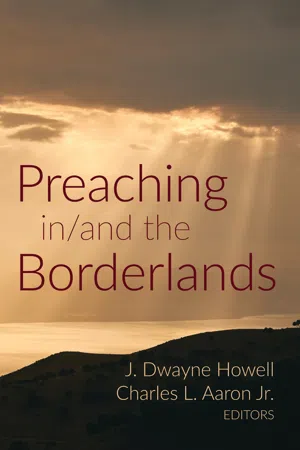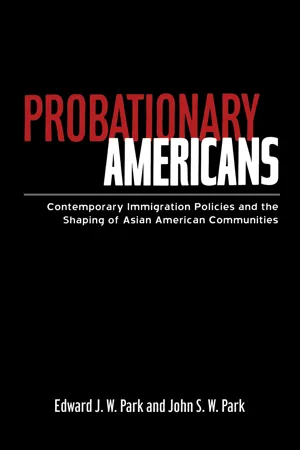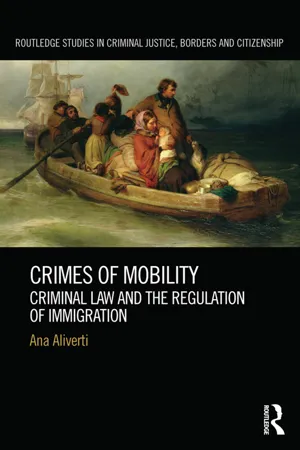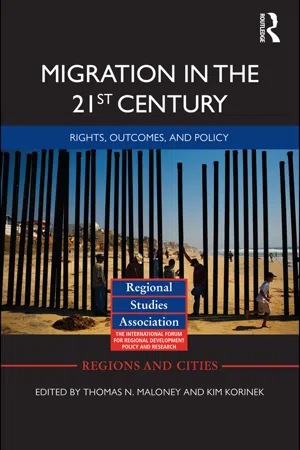Law
Immigration Law
Immigration law refers to the set of rules and regulations governing the entry, stay, and rights of foreign nationals in a country. It encompasses visa applications, deportation proceedings, and citizenship eligibility criteria. Immigration laws vary by country and are designed to manage the flow of people across borders while addressing national security, economic, and humanitarian concerns.
Written by Perlego with AI-assistance
Related key terms
8 Key excerpts on "Immigration Law"
- eBook - ePub
- Victor C. Romero(Author)
- 2015(Publication Date)
- Routledge(Publisher)
2 Immigration Law BasicsAs we learned in Chapter 1 , two sets of laws govern noncitizens in the United States: Immigration Law and alienage law. The first encompasses only the rules under which noncitizens are allowed to enter and must leave the United States, while the second focuses on the substantive rights and responsibilities of noncitizens under other federal, state, and local laws. For example, making sure that one has a valid visa is an Immigration Law requirement; whether a noncitizen is eligible to receive a state driver’s license is part of alienage law. For some, discriminating against noncitizens outside Immigration Law serves the same purpose as deportation: it is an effort to remove noncitizens by limiting their access to certain benefits.This chapter devotes its attention to the basics of Immigration Law. Accordingly, the focus will be on the rules governing admission (when a noncitizen may enter and under what status) and removal (when a noncitizen must leave). My goal is to give you a bird’s-eye view of basic Immigration Law so that when you seek help for a specific problem (be it filling out visa petition forms or avoiding deportation), you will be better equipped to determine whether you may be able to solve the problem yourself or require the assistance of qualified counsel. Here’s a fair rule of thumb: while it may be possible to complete many nonimmigrant and immigrant documents without hiring a lawyer when one seeks to enter the United States for the first time, it would be foolish to go without one when faced with deportation, especially if one has lived in the United States for many years and developed significant ties to this country.We learned in Chapter 1 that Congress has the power to set immigration rules. It did so in the Immigration and Nationality Act (INA, a confusing labyrinth even to seasoned lawyers).1 - eBook - ePub
- Austin Sarat, Patricia Ewick, Austin Sarat, Patricia Ewick(Authors)
- 2015(Publication Date)
- Wiley-Blackwell(Publisher)
Although readers may be inclined to dismiss Mr. Laínez’s experiences as an example of ongoing bad luck, the study of Immigration Laws reveals that immigrants’ “misfortune” is frequently the result of structural inequalities produced and maintained by US immigration policies. In his case, for example, the very policies that denied him a visa determined his separation from his family and shepherded him toward a form of travel involving unspeakable violence to get to the United States. Once in the country, US Immigration Laws provide only heavily restricted pathways to legalization that leave millions of people, like Mr. Laínez, outside of the law. Meanwhile, changing immigration policies at the federal, state, and local levels and increased enforcement practices create a context of generalized fear and repression in immigrants’ day-to-day lives, even when they are not actually detained. In the case of Mr. Laínez, it is in this context that he (like millions of other immigrants) is likely to be exploited and simultaneously prevented from pursuing his rights as a laborer.In this chapter, I examine how Immigration Laws powerfully structure everything from the journey of migration to migrants’ daily lives. Indeed, Immigration Laws have come to occupy an increasingly prominent place in research on immigrant integration in the twenty-first century. Determining who may enter and what rights migrants may access, these laws are important sites for the study of the production and maintenance of inequality, providing fruitful ground for the examination of a variety of empirical and theoretical puzzles in law and society research. Based mostly on the contemporary United States, this chapter explores the dynamic field of Immigration Law and society. It examines the key empirical and theoretical contributions of current scholarship and provides suggestions for future lines of research.The Work of Immigration Laws
In an effort to control the flow of international migration, nation-states implement Immigration Laws with globally dynamic consequences (Zolberg 1999). At the macro level, Immigration Laws determine the number and origin of authorized migrants, with shifts based purportedly on changing demographic and labor goals (Ngai 2004). Historically, countries around the world have opened doors for certain categories of migrants, often based on factors that include race, ethnicity, occupation, educational attainment, or financial resources (FitzGerald and Cook-Martín 2014). They have also barred entry to categories of people perceived to be threats according to shifting social and political prejudices and concerns (Luibhéid 2008). Consequently, as authorities enforce Immigration Laws, they also do the work of legitimating the nation-state’s boundaries – establishing physical borders and making explicit who is and who is not to be considered a member of the polity. - eBook - ePub
American Immigration
An Encyclopedia of Political, Social, and Cultural Change
- James Ciment, John Radzilowski(Authors)
- 2015(Publication Date)
- Routledge(Publisher)
Each aspect of immigration is governed by distinct rules. There are rules of admission to state territories and rules of sojourn that govern immigrants in their capacities as aliens (foreign nationals), members of society, and economic subjects (for example, how long they may stay in the country and whether they may work while there). Moreover, special rules govern the termination of a person’s immigrant status, either by repatriation or by naturalization. International law typically respects domestic policies so long as they are congruent with fundamental human rights standards.Emigration and Immigration
Article 13 of the United Nations (UN) Universal Declaration of Human Rights, adopted in 1948, and Article 12(2) of the UN International Covenant on Civil and Political Rights (CCPR) provide for the right of emigration. This right is the legal basis for flight from persecution.Both international and domestic law classifies people entering a country as either immigrants or nonimmigrants. Aliens are generally regarded as tourists if they do not stay for a period of more than three months or ninety days and do not seek employment. If they seek entry for the purpose of establishing a habitual residence, taking up permanent gainful employment, or engaging permanently in self-employed business, then aliens are regarded as immigrants.In addition, states employ nonimmigrant categories to administer sojourns for fixed periods and for purposes, such as economic activities they may engage in, that are specified before entry. However, provisions of the law frequently envisage or even encourage adjustment to immigrant status when nonimmigrants are able to contribute to the state’s common good.Many bilateral and multilateral treaties adopted at both the international and the regional levels put a special focus on global immigration, some of them within a multi-issue policy framework that may include economic and diplomatic issues. Many international agreements are designed to administer immigration in relation to other influential factors. Usually, these factors are categorized as “push” or “pull” factors. Push migration is motivated by conditions of life at the place of departure; it includes factors such as internal or international armed conflicts, political persecution by totalitarian regimes and other violations of human rights, forced resettlement (also referred to as “ethnic cleansing”), discrimination against vulnerable groups, terrorism, poverty and hunger, poor working conditions, natural disasters, and ecological devastation. Pull migration is motivated by expectations of living conditions at the point of destination, such as the availability of public assistance, the prospect of success in education, training and the labor market, political stability, constitutional democracy, pluralism, and effective protection of human rights. - eBook - ePub
- J. Dwayne Howell, Charles L. Aaron(Authors)
- 2020(Publication Date)
- Pickwick Publications(Publisher)
137 Within both sides, people disagree as to whom should be allowed to adjust status or naturalize while in the United States unlawfully; there is disagreement on caps on immigration from certain countries; there are those who oppose deporting criminals and those who favor deporting parents. There are those who oppose refugee admission and those who think we are doing far too little to mitigate the global crisis of displaced peoples.But also, Immigration Law is personal. When I think of restricting asylum, I think of my client who was raped by a soldier while her mother and father were killed in the same room. When I think about undocumented immigrants, I think of my client who, as a twelve-year-old, was trafficked across the southern border by a coyote and made her way to family in Ohio. She got pregnant along the way. When I think of family petitions, I remember explaining the visa bulletin to a pair of brothers. I watched them as they came to the realization that the enormous waiting list meant that they would never see their other brother again.We cannot forget the people behind the immigration structures we have created. We cannot forget the humanity behind the numbers. Understanding what the current system is will help us advocate for a fairer, more rational, set of laws, a set of laws that acknowledges the humanity in each immigrant.80 . This chapter is intended to give you a very basic overview of Immigration Law; it is not meant to provide any type of legal advice in any circumstance whatsoever. If you have an Immigration Law question, you should speak to an attorney. The Catholic Legal Immigration Network maintains a list of nonprofit immigration clinics in every state: https://cliniclegal.org.81 . For a more comprehensive overview of the history of Immigration Law, beginning with exclusionist policies in the colonies prior to the Declaration of Independence, see Kozen and Götzke, American Immigration Policy , 123 ; and John Powell, Immigration , 3 . For a comprehensive review of the politics behind Immigration Law in the United States, see Tichenor, Dividing Lines .82 - eBook - ePub
Probationary Americans
Contemporary Immigration Policies and the Shaping of Asian American Communities
- John SW Park, Edward JW Park(Authors)
- 2013(Publication Date)
- Routledge(Publisher)
PART I LawPassage contains an image
CHAPTER 2 Governing Admission to the United States: Basic ThemesIMMIGRATION LAW AS SOCIAL POLICY : SHAPING ECONOMY AND CULTUREImmigration Law in the United States has been shaped by much larger concerns about the type of political community that majorities of Americans have wanted. Immigration rules thus tell us a great deal about the various kinds of Utopian visions that American policy makers and voters have shared, both morally and politically. For example, immigration rules have long reserved important economic opportunities for American citizens first and, to the extent that immigrants encroach upon those opportunities, American citizens have demanded restrictive rules. For an extensive period of time, between 1882 and 1965, immigration rules also restricted Asians and other “undesirable races,” on the theory that such persons could never assimilate into, or be acceptable within, mainstream American society. In these ways, Immigration Law has always served as an important set of social policies that described what the United States should look like as a nation-state—free from persons who were economically or culturally threatening, attractive to those who contribute positively, and always mindful of protecting the interests of American citizens first.Several legal scholars have noted that American Immigration Law began in colonial times before the United States was a nation-state, when local authorities passed rules intended to stimulate desirable immigrants while, at the same time, excluding undesirables. Colonies, and then the states, attempted to control migration, promising land and tax benefits on the one hand, while passing outright bans on the entry of “convicts,” “paupers,” or “persons with loathsome diseases” on the other. In the Declaration of Independence, for example, Thomas Jefferson complained that George III “has endeavoured to prevent the population of these States; for that purpose obstructing the Laws for Naturalization of Foreigners; refusing to pass others to encourage their migrations hither, and raising the conditions of new Appropriations of Lands.” The American colonists had wanted the freedom to allow European migrants to establish even more settlements, and they accused the King of taking sides with the “merciless Indian savages” whose lands they coveted.1 - eBook - ePub
Just Immigration
American Policy in Christian Perspective
- Mark R. Amstutz(Author)
- 2017(Publication Date)
- Eerdmans(Publisher)
5 In addition, the law mandated the detention and deportation of those noncitizens (LPRs and unauthorized immigrants alike) who had been convicted of an “aggravated felony.” The law also expanded the offenses that qualified as “aggravated felonies” (e.g., tax evasion and receipt of stolen property) and applied this new standard retroactively to crimes committed in past years. Finally, the law restricted judicial review of immigration officials’ decision to deny admission.- The Homeland Security Act of 2002, which abolished the Immigration and Naturalization Service and transferred most of its functions to the Department of Homeland Security (DHS). Under the new law, immigration tasks are now handled by three bureaus: the Citizenship and Immigration Services (CIS), which processes immigrant and nonimmigrant petitions, naturalizations, asylum, and other related matters; the US Customs and Border Protection (CBP), which is responsible for inspection at ports of entry; and the US Immigration and Customs Enforcement (ICE), which enforces Immigration Laws within the country.
Despite the many changes in the INA, the 1952 statute remains the basic building block for US immigration policy. The INA is a large, complex document that is divided into titles, chapters, and sections.6 In the following, I describe some of the most important principles and guidelines of the US immigration system by focusing on: (1) nonimmigrant admissions; (2) immigrant admissions; (3) family-based preferences; (4) employment-based preferences; (5) diversity visas; and (6) refugees and asylum seekers.Admission of NonimmigrantsAs I have noted above, a nonimmigrant is an alien who seeks to enter the United States temporarily for business, pleasure, academic or vocational study, or temporary employment. Such a person is a resident of a foreign state who is committed to remain a national of that state. To be eligible for admission, a foreign national must meet the following criteria: establish that the visit is temporary; agree to depart at the end of the authorized visit; possess a valid passport; maintain a foreign residence (i.e., country of origin); be admissible; and abide by the terms of admission.Ordinarily, admission requires a visa that is secured by way of an application and an interview at a US embassy or consulate. To be admitted at airports and seaports, visitors must complete Form I-94, which records their arrival. Canadian and Mexican nationals with a border-crossing card are exempted from these requirements. In addition, some thirty-six countries participate in a Visa Waiver Program, which allows nationals of designated countries to travel to the United States as tourists or business travelers without a visa.7 In 2013, the leading countries for nonimmigrant admissions were Mexico (29 percent), the United Kingdom (7.5 percent), Canada (7.3 percent), and Japan (7 percent).8 - eBook - ePub
Crimes of Mobility
Criminal Law and the Regulation of Immigration
- Ana Aliverti(Author)
- 2013(Publication Date)
- Routledge(Publisher)
I argue that it is also important to look at the dynamics of immigration enforcement and the processing of immigration-related cases by the criminal justice system. From this perspective, the criminalization of migration appears to be a mundane, bureaucratic and repetitive exercise of criminal law powers geared by convenience and efficiency in delivering outcomes, rather than aiming to reflect a punitive rationale to censure wrongdoing. Criminal law is one of various enforcement tools to achieve the effective regulation of border and inland controls. Finally, I reflect on the role of criminal law and punishment against immigration wrongdoers. Because the goal is to eject them from the country once they have served their sentence, criminal sanctions against immigrants are emptied of any normative function and are unjustified.Criminalization the British wayAs this book has demonstrated, the inclusion of criminal offences in immigration statutes is not a new phenomenon. Legislation regulating the entry and residence of foreigners in eighteenth-century Britain contained many criminal law provisions. Similarly, criminal offences can be found in contemporary noncriminal legislation, such as competition, corporate, health and safety, and consumer laws. In fact, the trend to criminalize an ever expanding range of conducts is neither new nor confined to immigration legislation. Particularly in countries like Britain and the United States, criminal law has historically served functions seemingly extraneous to its core task of censuring wrongdoing (Lacey 2004; Husak 2008). More recently, the use of criminal law to ensure compliance with societal goals and roles has been identified by some authors as a main factor behind the expansion of criminal law and the redefinition of its boundaries (Ashworth 2000; McSherry et al. 2009; Duff et al. 2010).In this regard, Markus Dubber’s book The Police Power - eBook - ePub
Migration in the 21st Century
Rights, Outcomes, and Policy
- Thomas N. Maloney, Kim Korinek(Authors)
- 2010(Publication Date)
- Routledge(Publisher)
8 This is not to say that interaction between Western states was unimportant in the making of the law relating to the rights of aliens. We will elaborate on this point below.9 See, on this issue, the famous Supreme Court case of Johnson v. McIntosh ; as Chief Justice Marshall asserts there: “The title by conquest is acquired and maintained by force.” Further, he elaborates on the limits of the law: “However extravagant the pre-tension of converting the discovery of an inhabited country into conquest may appear; if the principle has been asserted in the first instance, and afterwards sustained; if a country has been acquired and held under it; if the property of the great mass of the community originates in it, it becomes the law of the land and cannot be questioned” (Johnson v. McIntosh , Supreme Court of the United States, 1823. 21 US (8Wheat.) 543, 5 L.Ed. 681).10 See also UNHCR 1951, Article 34; the major binding obligation of the Refugee Convention is the obligation of a state not to return a refugee to a country in which that refugee’s life or freedom would be threatened (Article 33).12 UDHR Article 13(2): “Everyone has the right to leave any country, including his own, and to return to his country.”11 A note about jargon is in order. Emigration is the exiting from a community of residence, while immigration is the movement into another state for long-term or permanent residence. Tourists and short-term visitors are not considered immigrants, although temporary labor migration may be treated as a form of immigration.13 Vance v. Terrazas , 444 US 252 (1980). More precisely, the Court said that the swearing of allegiance to another country could create a presumption of voluntariness, but that the Secretary of State would still need to show that the citizen intended to relinquish citizenship. This would be hard to show in the absence of specific notice of the consequences of the oath.14 The nondiscrimination treaty has an important effect because it reinforces the principle that rights embodied in other treaties must apply to all regardless of nationality. Further, the Human Rights Committee, which is given the task of implementing the treaty, has asserted that differential treatment based on nationality “will constitute discrimination if the criteria for such differentiation are inconsistent with the objectives and purposes of the Convention” (Weissbrodt 2007: 224–225).
Index pages curate the most relevant extracts from our library of academic textbooks. They’ve been created using an in-house natural language model (NLM), each adding context and meaning to key research topics.
